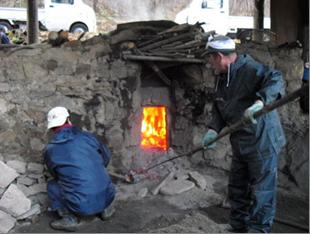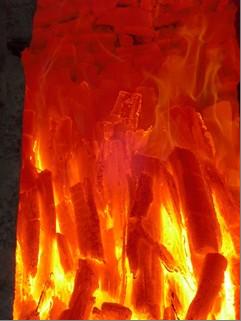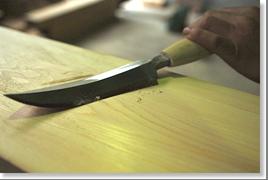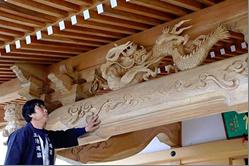The disappearance of handicrafts and hand trades in Japan is scarcely a recent phenomenon. Although a few isolated survivors can still be found, precious few vestiges of handwork remain in our day-to-day lives.
If this means nothing more than that hand-crafted objects were replaced by mass-produced factory goods, then the loss does not seem so great, especially when one considers all the modern, convenient, durable, and inexpensive items to which we have access. But in fact, there is much more to it than that.
When hand-made objects vanished from our lives, the culture and traditions that had grown up around them vanished as well. To appreciate the extent of this loss, we need to examine the change from two perspectives, that of the producers and that of the consumers. For now, we will focus on the producers.
Learning and Growing in the Totei System
Traditional Japanese artisans almost invariably learned their trade through a long apprenticeship to a master. Under the totei system, an aspiring artisan would be apprenticed from an early age, generally living in the master's house. The master was not an educator per se and did not make use of textbooks or any other teaching aids. Simply put, the apprentice learned by observing and assisting. In some cases, assistance included menial labor and household chores like cleaning, doing the laundry, and babysitting. Eventually such practices were criticized as archaic, and since the end of World War II, the system has all but died out.
Certainly the apprenticeship system can appear archaic in the light of modern educational practices. Classroom education focuses on the memorization of facts and figures via textbooks and other forms of verbal transmission. But traditional artisans and tradespeople rarely used words to transmit what they knew. The reason is that words were of almost no use in transmitting the kind of skills they possessed.

(Courtesy Takeshi Sumibito Kai)
To better appreciate this, imagine yourself training to become a charcoal maker.
The basic steps involved in making traditional Japanese charcoal are building a kiln, cutting the wood and loading it in the kiln, firing, closing the kiln door at a particular time, and allowing the wood to rest a certain amount of time before removing it. A clay kiln is used for the softer black charcoal, a stone one for the highly prized bincho charcoal, also known as white charcoal. (The two types of coal also require slightly different treatment near the end of the process, but such details can be ignored for our purposes.)
Now, you might think it simple enough for the master to write the instructions for each step on paper for you. But because of the multitude of variables involved in each step, such written instructions would be virtually useless.
Beginning with the kiln, stone and clay vary by locale. Even in one locale, no two stones or deposits of clay are the same, and some are much better suited than others. Even if you learned the principles of building the ideal oven on paper, you could never know whether you had successfully applied those principles until you tried the oven. As a charcoal maker, you need to spot and fix problems as you go along. The proper makeup and construction of your kiln will depend on all manner of climatic and environmental factors.
Even the loading of the wood into the kiln requires the kind of know-how that comes only from experience. Like most hand trades, charcoal making is not highly profitable, so you need to produce as much charcoal as possible each time you fire up the kiln. For that purpose, you need to arrange the wood in such a way as to fit as much as possible at a time, without compromising the quality of the final product. And since no two batches of wood are the same, the arrangement will differ from one firing to the next.
After the wood is loaded and the kiln fired up, you must carefully monitor both the color of the flame and the color and smell of the smoke. The color of the flame indicates the temperature, while the color and smell of the smoke provide important indicators of changes going on within the kiln. These days there are thermometers that can record very high temperatures, but in the past, the color of the fire was the surest way to gauge the temperature regardless of the material or construction of the kiln. How the fire reaches the correct temperature is also important.

As the carbonization process proceeds, the color and odor of the smoke gradually change. The smoke that initially pours out of the kiln is white, but it gradually turns purplish and then dwindles to almost nothing. The smell also changes, from a pleasant smoky fragrance to a sharp, acrid odor. Since the subtle differences in color and smell are impossible to describe in words, the master charcoal maker can only admonish you to memorize them. In time, after repeated failures and admonitions, you will absorb your master's ability to distinguish those smells and colors—that or you will never learn to make charcoal. Since your master cannot bequeath you his or her eyes and nose, your only choice is to learn through example and experience.
Now let us suppose you are training to become a miya-daiku , a master carpenter who builds and repairs wooden shrines and temples. For the longest time you find yourself doing nothing but sweeping and lugging tools and lumber. You are eager to take up your tools and begin sawing and planing wood into beams and posts, but that must wait; everyone must start at the bottom, doing menial work. To begin with, the master has to show you what kind of work a carpenter does. You need to learn how to walk, move, and behave at a building site amidst sharp chisels and saws and pieces of lumber large enough to crush a person. How can you even begin to take part in the actual building before you have thoroughly familiarized yourself with the weight, texture, and smell of the wood, with carpenters' jargon and the names of all the members and elements of a building? In the process of sweeping, carrying tools, and doing other menial jobs, you gradually gain a familiarity with the work place and acquire a visceral understanding of what it means to be a carpenter. Only then can you respond appropriately when told to do something and steer clear of countless workplace hazards.
A carpenter's work involves shaping wood members, cutting them to measure, drilling holes in it, and joining them together, and each of these processes involves the mastery of difficult skills. Unless you know just how to wield the saw, you will wear yourself out without accomplishing anything. Even with the benefit of guidelines clearly drawn on the wood, your saw will not cut straight. When sharpening the plane, you know you need to make the blade perfectly straight and level, but in trying to correct a blade that slopes slightly to the right, you overwork it so that it instead slopes to the left. Your mind knows exactly what needs to be done, yet your hands are unable to do it. Your whole body must be trained and disciplined to do as your mind bids, and books and verbal instructions are of no use in that kind of training.

When you have finally begun to get the hang of these tools, your master gives you a board and tells you to plane it flat. You carefully sharpen the blade, meticulously shave the board, and measure it to make sure it is perfectly level. You then ask your master to check your work. "What's this?" he cries disapprovingly. "I told you to make it flat!" You're bewildered. When you measured it with your ruler, it was perfectly level. Finally, a senior apprentice comes over and explains. You can't rely on a ruler, he says consolingly. You have to use your own eye. A perfectly flat plane looks slightly concave to the eye, which is why a plasterer will finish his wall by creating a slight swelling in the middle. No one can tell you by how many centimeters. Only your intuitive visual judgment can tell you whether it looks flat. Cultivating this judgment is part of becoming a carpenter, but there are no words that can impart it. You must simply absorb the judgment, intuition, and sensibility of your master. In this way, you gradually learn to use the tools of your trade and distinguish between superior and inferior work.
The totei system evolved to allow the transmission of skills and understanding from person to person, body to body. Instead of cramming one's head full of abstract knowledge, it physically imprinted the required techniques and aesthetic judgment, training one's hands to execute and one's eyes to discern instinctively. This was the raison d'être of the totei system, however irrational and inefficient it might appear.
The belief that it is possible to learn anything through written words, numbers, textbooks, and a teacher who explains everything patiently is an illusion. Of course, there are those who believe that one can dispense with arduous training by replacing color and smell with numerical values and by teaching machines how to perform the most technically demanding tasks. In fact, our factories are full of such sophisticated robots, which are able produce goods meeting exacting standards. And if consumers are satisfied with that, so be it.

But the long process of honing one's own skills and perceptions is not just about producing a perfect product; it is also a process of personal growth as a human being. It is only after you confront your own shortcomings, endure rebukes, and lament your own inexperience that you realize there is no substitute for tireless effort and persistence. You become committed to progress, however slow, and take satisfaction in knowing you are a little better today than you were yesterday, and will be a little better tomorrow than you are today. You keep working, you grow stronger, and you mature as a human being.
Today, sophisticated machines read the data we input and create the products we instruct them to, and that is all. We seek only speed, low cost, and efficiency. Underlying it all is a cold, mechanical, and single-minded pursuit of efficiency.
The traditional apprenticeship system, on the other hand, was a means of nurturing human beings. And that is something precious that we have lost.
A Unique Relationship with Nature
Most of the materials used in the traditional handicrafts and hand trades were taken from the immediate environment. And since fine work requires fine materials, part of the body of knowledge transmitted from generation to generation was an understanding of the materials of one's craft and how to extract or harvest them from the environment. This included strict rules regulating that process to prevent the depletion of the resources on which the trade depended.
For example, the artisans of Akita Prefecture who wove baskets and other objects from akebia vine did not begin harvesting the vine until after midsummer. By allowing the vine to grow as long as possible before cutting, they were able to maximize and conserve that resource.
There were different rules for all such materials. Bark was collected only from the rainy season (June) on. Lumber could only be cut from late autumn or winter, after the leaves had fallen and the trees' growth had stopped, to around March the following year, before the sap began to flow. Bamboo, likewise, could only be cut in the winter, when the plants were dormant. And never was the "parent tree" cut down. This meant, in the case of akebia , cutting only the vines and leaving the trunk intact. When harvesting spicebush wood for toothpicks, one could cut the long branches, but the base was left untouched.
This ensured that the vines or the bush would grow back the following year.
When deciduous trees are cut near the base, they will usually put out tillers. If the most promising tiller is left intact, it will eventually grow back into a usable tree. In the case of the ubame oak—used in the making of fine bincho charcoal—it takes 15 to 20 years for a tree to regenerate and grow back to a size suitable for making charcoal. Japanese ( nara ) oak, sawtooth oak, and other trees used for black coal take about 20 years to regenerate, as does the Japanese basswood ( shina ) trees used to weave basswood cloth. Even if you cut down the urushi tree used for making lacquer, it will regenerate and, in about 20 years time, once again produce sap suitable for making lacquer. Japanese cedar and cypress for construction purposes take much longer. Such trees were only cut down when they were 60 to 100 years old, and then seedlings were planted in their place.
By using the forests and woodlands cyclically in this way, artisans could ensure that the supply of materials would never dry up. But such careful use of resources was based on the assumption that one's children and grandchildren would be following in one's footsteps. An artisan who knew that the business would end when he or she died might just as well cut down the parent tree or leave the tillers to grow as they might. In such cases, the forests would no longer serve as sources of renewable resources.
People often assume that nature can renew itself without human assistance. But the natural materials that are most useful to people need to be tended and cultivated. High-quality materials do not grow by accident. Even the miscanthus and reeds used to thatch roofs required cultivation. After they were cut, the field was burnt and fertilizer applied so that the grasses could be harvested again later. A durable thatched roof cannot be made from the kind of reeds that grow randomly by the riverside.
With the demise of handicrafts and hand trades, our view of nature changed. We lost the underlying belief that we ourselves benefit by skillfully coexisting with nature. For the Japanese, this was a huge transformation.
By changing our ideas about production, the demise of handicrafts also altered our attitudes toward education, human relations, and the environment. In the next article in this series, we will examine the repercussions of the great handicraft extinction from the standpoint of consumption.
Takeshi Sumibito Kai's blog (Japanese only)
http://sumibito.seesaa.net/
Mitsunari Sakurai's blog (Japanese only)
http://miyadaiku.info/sakurai/index.html
